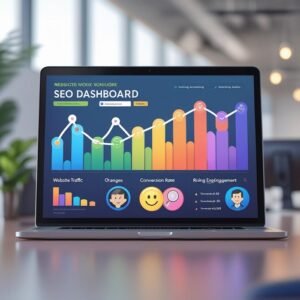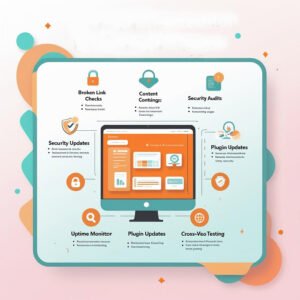Your website is the digital face of your business. It should do more than just look good—it needs to drive conversions, turning visitors into customers. But if your traffic isn’t translating into sales or leads, something is wrong. Many businesses struggle with low conversion rates because of issues they don’t even realize exist. A slow, confusing, or untrustworthy website can silently push potential customers away, costing you valuable revenue.
What You’ll Learn in This Blog
In this blog, we’ll uncover the most critical reasons why your website is failing to convert visitors into customers. We will explore issues such as slow loading speeds, poor mobile experience, weak call-to-actions, and outdated design. More importantly, we’ll provide clear solutions to these problems so you can transform your website into a high-performing business asset.
The Reasons Behind Low Conversions and Their Fixes
1. A slow-loading website
It is one of the biggest culprits behind high bounce rates. Studies show that users abandon sites that take more than three seconds to load, and if your site is sluggish, potential customers will leave before they even see what you offer. In this case, optimizing images, enabling caching, using a content delivery network (CDN), and investing in a reliable hosting provider can significantly improve speed and keep visitors engaged.
2. Mobile experience plays a crucial role in conversions
More than half of web traffic comes from mobile devices, and if your website isn’t responsive, users will struggle with navigation, zooming, and distorted layouts. A seamless mobile experience can be achieved through responsive design, optimizing fonts and buttons, and testing the site across different devices to ensure a smooth browsing experience.
3. A confusing navigation structure
This can frustrate users, making it difficult for them to find what they need. If visitors have to hunt for information, they’ll leave and look elsewhere. Keeping the menu simple, using clear labels, and incorporating a search bar can help users find what they’re looking for quickly, increasing their chances of converting into customers.
4. Weak or unclear call-to-actions (CTAs)
It can lead to missed opportunities. If your CTAs are generic or blend into the design, visitors won’t be compelled to take action. Strong CTAs should use action-driven language, be visually distinct with contrasting colors, and be strategically placed throughout the site to encourage conversions.
5. Lack of trust signals
This can make visitors hesitant to do business with you. If your website doesn’t showcase credibility, potential customers may question the legitimacy of your brand. Adding customer testimonials, displaying security badges, and showcasing case studies or success stories can build trust and encourage visitors to take the next step.
6. Content strategy
It plays a major role in engaging visitors. If your website features outdated, unclear, or irrelevant content, it can create confusion and lead to higher bounce rates. Keeping content clear, concise, and informative, using high-quality visuals, and updating blog posts and landing pages regularly can make your website more engaging and conversion-friendly.
7. An outdated or cluttered design
It can leave a negative first impression. A website that looks unprofessional or visually overwhelming can turn visitors away before they even explore your offerings. A clean, modern layout with consistent branding, high-quality visuals, and well-structured content can create a positive user experience and make visitors more likely to convert.
8. A lack of personalization
This can result in a generic user experience that fails to engage visitors. Personalized experiences, such as dynamic content recommendations, live chat support, and targeted discounts based on user behavior, can significantly improve engagement and lead to higher conversion rates.
9. An unclear value proposition
This can confuse visitors and make them question why they should choose your business over competitors. If your website doesn’t immediately communicate your unique benefits, visitors will move on. Clearly stating your value proposition on the homepage, highlighting customer-centric benefits, and focusing on how your product or service solves a problem can improve conversions.
10. A complicated checkout process or contact form
This can cause potential customers to abandon their purchase or inquiry. If forms are too long, require unnecessary information, or have a confusing layout, users are more likely to leave without completing the process. Simplifying forms, asking only for essential details, offering multiple payment options, and optimizing the checkout flow can help minimize drop-offs and increase conversions.
Conclusion
A website that fails to convert is more than just a missed opportunity—it’s a silent business killer. Addressing these common issues can significantly improve user experience, engagement, and ultimately, conversions. At EncoderLabs, we specialize in creating high-performing websites that drive real business results. Whether it’s optimizing speed, refining design, or improving CTAs, we help businesses turn visitors into loyal customers. Don’t let an underperforming website hold you back. Contact us today for a consultation and start converting more visitors into customers.




